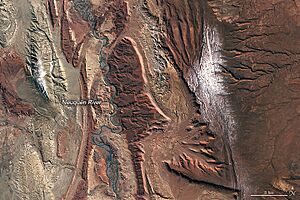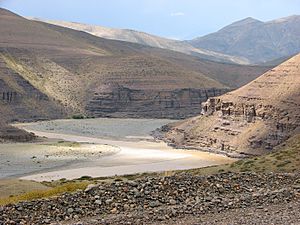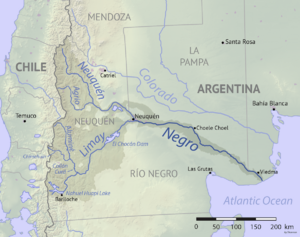Neuquén River facts for kids
The Neuquén River (called Río Neuquén in Spanish) is a very important river in the Neuquén Province in Argentina. It flows through the Patagonia region. This river is the second most important in the province, after the Limay River. The rocks around the Neuquén Basin are famous for fossils. They also hold large amounts of oil and gas.
Contents
Journey of the Neuquén River
The Neuquén River starts high up in the northwest part of the province. It begins at about 2,300 meters (7,500 feet) above sea level. Many smaller streams flow into it from the lower Andes mountains. These streams come from small lakes and valleys. Some of these important streams are the Trocomán, Reñi Leuvü, Agrio, and Nahueve.
Further along, the river gets water from its main branches, the Varvarco and Agrio rivers. The Agrio River alone adds almost one-third of the Neuquén River's water! Sometimes, the river also carries sediments from the Copahue and Domuyo volcanoes. These sediments can make the water a bit cloudy.
Controlling the River's Flow
After the Agrio River joins it, the Neuquén River does not have any natural lakes to control its water flow. This means its water level can rise very quickly. This often happens during times of melting snow or heavy rain.
To help with these sudden changes, engineers built a special channel. This channel sends some water to the Pellegrini Lake in Río Negro Province. They also built the Cerros Colorados Complex. This complex helps control the river's flow and also creates hydroelectricity. Hydroelectricity is power made from moving water.
Where the River Ends
The Neuquén River has an average flow of about 308 cubic meters (10,877 cubic feet) of water per second. Its entire drainage area covers about 50,774 square kilometers (19,604 square miles).
The Neuquén River meets the Limay River near the city of Neuquén. When they join, they form the Río Negro. The Río Negro then continues its journey east until it reaches the Atlantic Ocean.
Fishing in the River
Even though it's not as famous as some other rivers, the Neuquén River is a great spot for fishing. People who enjoy fly fishing and spinning often visit. The two artificial lakes nearby, Los Barreales and Mari Menuco, are also popular. The main fish caught here are trout and Patagonian pejerrey.
Ancient Rocks and Dinosaurs
The Neuquén Basin is a fascinating place for geology and fossils.
Candeleros Formation Rocks
If you look at satellite images, you can see deep red rocks. These are part of the Candeleros Formation. These rocks are sandstones that formed about 90 to 100 million years ago. Back then, this area had many braided rivers. Next to these red rocks, especially near the river, you might see green-yellow rocks. These are from the younger Hunical Formation. They formed during drier times.
Dinosaur Discoveries
Paleontologists are scientists who study fossils. They have found many amazing fossils in the Candeleros rocks. These include ancient fish, frogs, snakes, turtles, and small mammals. They have also found several types of dinosaurs!
One of the most famous dinosaurs found here is Giganotosaurus carolinii. This was a meat-eating dinosaur, a theropod. Scientists believe it was even bigger and faster than the famous Tyrannosaurus rex!
Energy Resources in the Basin
Recently, a large amount of natural gas and oil was found deep within the Vaca Muerta formation. This discovery has made the Neuquén Basin an important area for finding energy resources.
See also
 In Spanish: Río Neuquén para niños
In Spanish: Río Neuquén para niños




